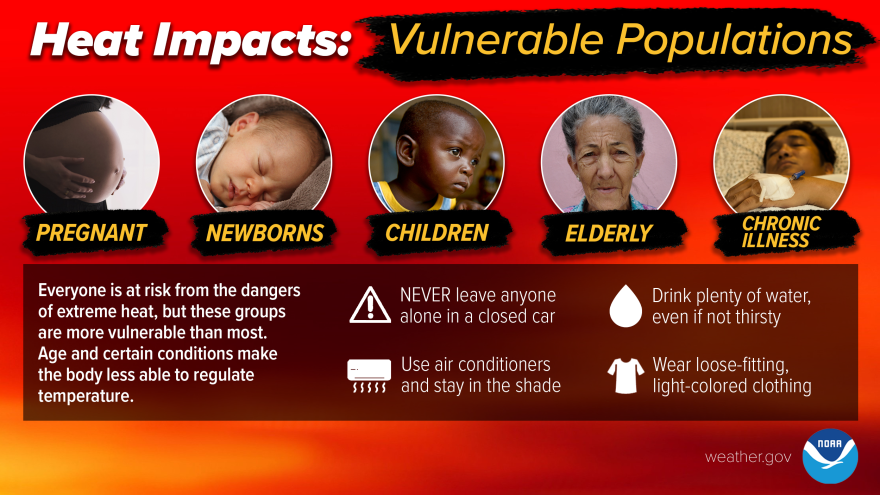It's going to be hot out there, Idaho. Here are tips for staying cool.
One hundred degree temperatures are back in the forecast this week. If you're planning on getting out and about, you need to know how to take care of yourself (and your pets!) in the heat.
🌡️ Hot afternoon temperatures expected Monday through Wednesday, with Tuesday being the peak. Lower elevations will be near to just above 100 degrees, while mountains and highlands are in the 90s and 80s. #idwx pic.twitter.com/f1C4MX20VW
— NWS Boise (@NWSBoise) August 10, 2025
Heat advisories are not unusual in Idaho, with the National Weather Service issuing them frequently throughout the summer. A heat advisory is when the maximum heat index temperature is expected to be 100 degrees or higher for at least two days and night time air temperatures do not drop below 75 degrees.
NWS Boise said in the Excessive Heat Watch that the longevity of this weather event will make it a particularly dangerous heat wave.
Triple-digit temps feel pretty familiar to certain parts of Idaho – there were 27 days of 100+ degree temperatures in 2022, which the National Weather Service says is an all-time record. The previous record was 20 days, set in 2003.
Keeping cool in heat like this should be top of mind, for yourself and your community. Heat is one of the leading causes of weather-related fatalities, according to the National Weather Service.

During extreme heat warnings, remember:
- Stay indoors, with air conditioning when possible
- Drink plenty of water
- When outside, limit sun exposure & seek out shade
- Avoid strenuous activities
- Wear light or loose-fitting clothing
- Check on family and neighbors
Extreme heat can also affect our infrastructure – think irrigation, agriculture, transportation and electricity.
Tips from Idaho Power to keep your home cool:
- Ceiling fans can make the air feel several degrees cooler.
- Make sure your fan is spinning counterclockwise in the summer to create a downdraft to maximize the cooling sensation
- But remember: fans cool people, not rooms. Turn them off when you leave the room.
- Cover windows with drapes or shades
- Use appliances that create heat (think: oven, dryer, dishwasher) in the early morning or late evening to avoid the hottest times of the day.
- Or don't use those hot appliances at all! Consider grilling on the porch or line-drying your laundry outside.
- To cool down, take a cool shower or wear lightweight clothing, rather than cranking the AC.
- If you're leaving your house for a few days, turn off the air conditioning.
Prolonged exposure to heat can result in heat stroke and heat exhaustion.
Know the signs of heat-related illnesses:
Text equivalent of heat-related illnesses.
At-risk populations for heat-related illness include
- Older individuals
- Pregnant women
- Newborns
- Children
- Individuals experiencing homelessness
- Those with underlying health conditions
- Pets

Keeping your pets safe
The Humane Society of the United States has several suggestions to keep your pets safe during the hot weather.
- Never leave your pets in a parked car, even with it running and the air conditioner on
- Watch the humidity. High humidity amplifies the negative impact of high temperatures on your pet, and in combination they can magnify the danger zone
- Limit exercise on hot days, adjust the intensity and duration in accordance with the temperature
- Don't rely on a fan, they don't cool pets off as effectively as they do people
- Provide plenty of shade and water any time your pet is outside. The Humane Society says add ice to water when possible and tree shad and tarps are ideal because they don't obstruct air flow
- Watch for signs of heatstroke, which include heavy panting, glazed eyes, a rapid heartbeat, difficulty breathing, excessive thirst, lethargy, fever, dizziness, lack of coordination, vomiting, profuse salivation, a deep red or purple tongue, seizure and unconsciousness.
If your pet is suffering from heatstroke, the Humane Society of the United States says to move them into the shade or an air conditioned area. Apply ice packs or cold towels to their head, neck and chest or run cool water over them. Let them drink small amounts of water and take them to a veterinarian.



